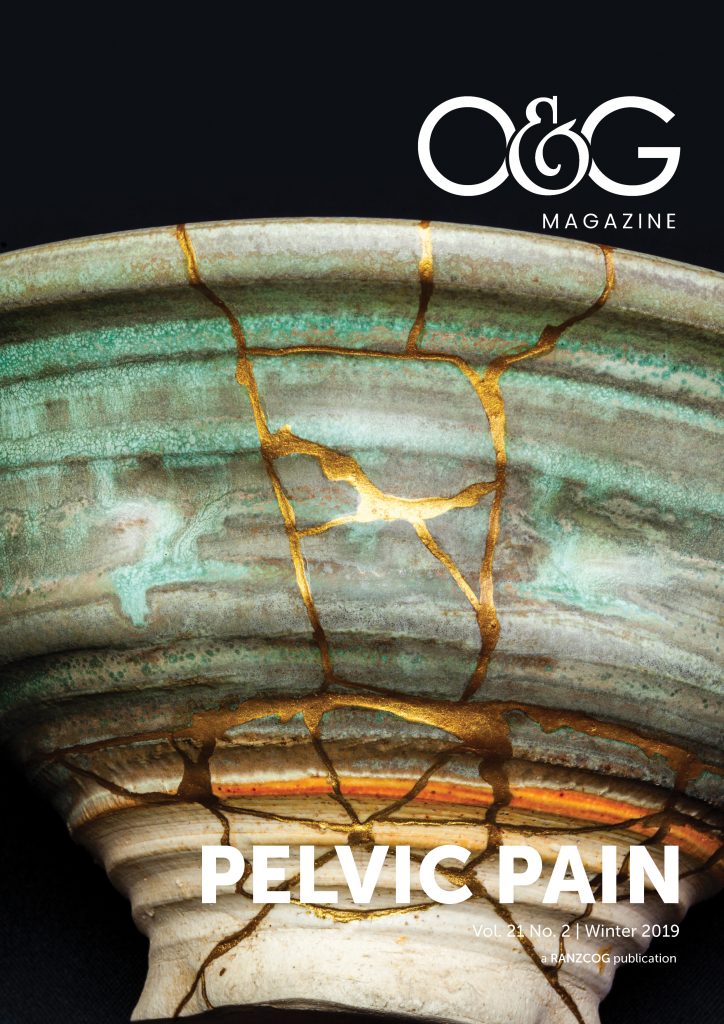Persistent pelvic pain (PPP) affects 15–26 per cent,1 2 of women. It is defined by pelvic pain for more than 3–6 months that is not solely related to menstruation, sexual activity or bowel movements.3 PPP is caused by a complex combination of visceral and musculoskeletal pain, central sensitisation and pelvic floor hypertonicity, often accompanied by evolving psychological dysfunction.4 5 6 7 Acute exacerbations (flares) of pelvic pain are common and often triggered by menstruation, constipation, UTI/bladder pain or pelvic muscle spasm.8 Flares can last days to months and the patient will often have significant fear and anxiety relating to escalation of their pain. The result is frequent presentation to primary care providers and the emergency department (ED), where previously normal investigations are often repeated and admission (with repeat diagnostic laparoscopy) undertaken. This scenario is frustrating to both patient and clinician and results in excess hospital expenditure. We developed a guideline for acute management of PPP flares with the aim of preventing unnecessary investigation, admission and surgery. Management focuses on identification and treatment of specific triggers while providing validation, reassurance and education to the patient.
Persistent pelvic pain: the burden
PPP poses a significant societal and healthcare burden. In Australia, the cost of medical and surgical treatment for endometriosis alone amounts to over six billion dollars per year. Globally, this results in 11 hours and $200–250 lost per woman, per week, due to absenteeism and presenteeism, where an employee is working with reduced productivity.9 Given that many ED presentations result in admission and diagnostic laparoscopy, the cost of which is up to $4289 USD,10 there is clearly benefit to be gained from avoiding such intervention in the previously investigated PPP patient, when clinically appropriate. Additionally, if adequate education and reassurance can be provided in the acute setting, the patient may be more likely to accept ongoing outpatient management.
It is well established that a multidisciplinary approach to the management of PPP results in improved patient outcomes.11 12 13 In June 2017, the Mater Mothers’ Hospital Persistent Pelvic Pain Clinic (PPPC) was opened with the dual aims of improving patient outcomes and reducing hospital costs associated with unnecessary admissions or procedures. The changes made include the development of guidelines for the acute management of pelvic pain in the ED, and an effective multidisciplinary team approach to management in the clinic.

Figure 1. MDT management can be likened to a door with many locks; unlocking one is insufficient to allow patients to open the door. Instead, multiple locks need to be targeted in order to free women from the constraints of ongoing pain.
Management in the emergency department
The following guidelines provide a consistent approach to management following exclusion of acute intra-abdominal pathology. They educate women on strategies to improve their pain over the longer term, and support them to manage pain flares, avoiding the need for unnecessary presentation to ED. The principles of management are:
- Exclude acute intra-abdominal pathology
- Confirm symptoms consistent with an exacerbation of long-term pain
- Recognise and manage the likely trigger for the recent flare of pain
- Appropriate analgesia with avoidance of opioids
- Avoidance of repeat laparoscopy
- Assessment of psychological stressors and risk of self-harm
- Reassurance and acknowledgement of the patient’s pain despite normal investigations
- Education and emphasis on self-management
- Appropriate follow up
| History |
A thorough, but timely, patient history should be obtained that is not biased by previous admissions or diagnosis:
|
| Examination |
The patients examination should ideally be performed in a safe, and comfortable environment by an experienced practitioner:
|
| Investigations |
The patients investigations should be performed to support clinical findings and not used in a ‘scattergun’, cover all possibilities approach:
|
| Management |
|
Ongoing management in the PPPC
As of November 2018, 58 patients have commenced in the service. The core team includes advanced laparoscopic gynaecologist, pain specialist, psychologist and physiotherapist, with referral pathways to psychiatry, functional gastroenterology and colorectal surgeons. The structure comprises a six-month program with an initial, three- and six-month visit, as well as regular physiotherapy and psychology intervention. A general summary of long-term management in the PPPC includes:
- Emphasis on self-management and expectation setting: aim for pain reduction to a level that facilitates improved functioning and a return to usual activities with ongoing management planned as outpatient
- Provision of written and verbal information regarding long-term treatment and management of pain flares
- Complete laparoscopic excision of endometriosis by experienced endometriosis surgeon, as clinically indicated
- Achieving amenorrhoea with hormonal suppression
- Weaning off opioid medication
- Modulation of pain pathways using antidepressants (amitriptyline/duloxetine) or membrane stabilisers (gabapentin/pregabalin)
- Physiotherapy for pelvic floor downtraining with experienced women’s health physiotherapist
- Psychology/psychiatric input
- Persistent Pain Education module
- Administration of pelvic floor botulinum toxin as clinically indicated
The acute exacerbation of PPP can be a frustrating encounter for both patient and clinician, frequently resulting in unnecessary intervention that yields little information or clinical improvement. By directing acute management at diagnosing and treating triggers, providing education and instituting multidisciplinary follow up, the patient can potentially be adequately managed as an outpatient, avoiding admission and its associated problems. As part of an auditing cycle, the Mater Mothers’ PPPC is collecting prospective outcome data on all clinic attendances and is in the process of integrating with the Electronic Persistent Pain Outcomes Collaboration system.
References
- Latthe P, Latthe M, Say L, et al. WHO systematic review of prevalence of chronic pelvic pain: a neglected reproductive health morbidity. BMC Public Health. 2006;6:177.
- Grace V, Zondervan K. Chronic pelvic pain in New Zealand: prevalence, pain severity, diagnoses and use of the health services. ANZ J Pub Health. 2004;28:369-75.
- Jarrell JF, Vilos GA, Allaire C, et al. Consensus guidelines for the management of chronic pelvic pain. J Obstet Gynaecol Can. 2005;27:781-826.
- Jarrell JF, Vilos GA, Allaire C, et al. Consensus guidelines for the management of chronic pelvic pain. J Obstet Gynaecol Can. 2005;27:781-826.
- Alappattu MJ, Bishop MD. Psychological factors in chronic pelvic pain in women: relevance and application of the fear-avoidance model of pain. Phys Ther. 2011;91:1542-50.
- Kwon JK, Chang IH. Pain, catastrophizing, and depression in chronic prostatitis/chronic pelvic pain syndrome. Int Neurourol J. 2013;17:48-58.
- Meltzer-Brody S, Leserman J. Psychiatric comorbidity in women with chronic pelvic pain. CNS Spectr. 2011;16:29-35.
- Evans S. Management of Persistent Pelvic Pain in Girls and Women. Aust Fam Phys. 2015;44:454-9.
- Bush D, Evans S, Vancaillie T. The Pelvic Pain Report: The $6 billion woman and the $600 million dollar girl. 2011, Australia.
- Fuldeore M, Chwalisz K, Marx S, et al. Surgical procedures and their cost estimates among women with newly diagnosed endometriosis: a US database study. J Med Econ. 2011;14(1):115-23.
- Allaire C, Williams C, Bodmer-Roy S, et al. Chronic pelvic pain in an interdisciplinary setting: 1 year prospective cohort, Am J Obstet Gynecol. 2018;218(1):114.e1-12.
- Allaire C, Aksoy T, Bedaiwy M, et al. An interdisciplinary approach to endometriosis-associated persistent pelvic pain. J Endo Pelvic Pain Disord. 2017. doi:10.5301/jeppd.5000284.
- Stanos S, Houle TT. Multidisciplinary and interdisciplinary management of chronic pain. Phys Med Rehabil Clin N Am. 2006;17:435-50.
- Rogalski MJ, Kellogg-Spadt S, Hoffmann AR, et al. Retrospective chart review of vaginal diazepam suppository use in high-tone pelvic floor dysfunction. Int Urogynecol J. 2010;21(7):895-9.








Leave a Reply